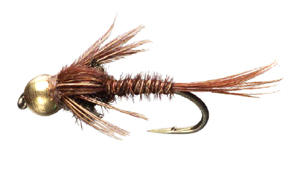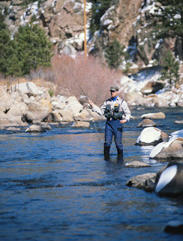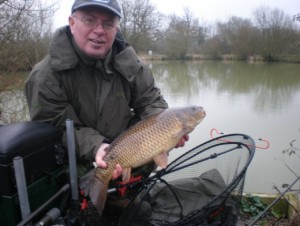The first bead-head patterns were fished in Northern Italy's picturesque Alps during the late 1980's. European anglers around this geographic area were successful using bead-heads for both trout and grayling. Roman Moser, one of Germany's most innovative fly tiers and fisherman is credited with many of the initial bead-head flies commonly found in fly-fishers' vest today.
America was introduced to this new nymphing concept by Tom Rosenbauer's story titled "Bead Heads" in the July 1993 issue of Fly Fisherman magazine. A large portion of the bead-heads' success is due to the sparkle or attraction principles of the solid brass bead. One "school of thought" believes its effectiveness is a result of this sparkle because emerging insects develop a "gas-like" bubble between the exoskeleton and the skin of the emerging nymph producing a mirror-like appearance. Others suggest, and probably the most valid phenomenon, the fly gets "down" to the fish quicker than flies without beads.

Bead-head patterns can imitate a variety of food organisms including mayflies, midges, caddis flies, stoneflies, minnows, and leeches. The Bead-Head Pheasant Tail is a beautiful mayfly representation that fishes well in shallow riffles and can be deadly in off-colored water especially during spring run-off conditions.
Frank Sawyer is credited with the original version of the Pheasant Tail dating back to the early 1930's. In its embryonic form the fly was constructed from only two materials-copper wire and pheasant tail fibers (no thread!). Al Troth, one of the country's leading fly tying authorities from Dillon, Montana is noted for the peacock thorax version found in many fly shops throughout the country.

The most productive method to fish your Bead-Head Pheasant Tail is on the dead drift. Your nymphing rig should consist of a 7 1/2 foot 5X tapered leader, an adjustable yarn strike indicator, two flies, and a small piece of soft lead 12" above the upper fly. For best results use the Bead-Head Pheasant Tail as an attractor and trail a smaller nymph behind it with an additional 12" section of 6X tippet material.
Spring fly-fishing can be one of the more rewarding times of the year to fish. The trout go through a drastic metabolic change as the water temperature gradually increases to the mid 40's. When the water temperature reaches 42-44 degrees the blue wing olives will begin to hatch. The fish move out of the deep, slow pools and begin feeding in the swifter shallow riffles looking for mayfly nymphs. The rainbows are starting to spawn which is a sure sign spring is right around the corner. We hope your hectic schedule allows you a break in the action to experience a warm spring day on your favorite stream. Remember to keep the tip up!
 Bead-head patterns can imitate a variety of food organisms including mayflies, midges, caddis flies, stoneflies, minnows, and leeches. The Bead-Head Pheasant Tail is a beautiful mayfly representation that fishes well in shallow riffles and can be deadly in off-colored water especially during spring run-off conditions.
Bead-head patterns can imitate a variety of food organisms including mayflies, midges, caddis flies, stoneflies, minnows, and leeches. The Bead-Head Pheasant Tail is a beautiful mayfly representation that fishes well in shallow riffles and can be deadly in off-colored water especially during spring run-off conditions.
 The most productive method to fish your Bead-Head Pheasant Tail is on the dead drift. Your nymphing rig should consist of a 7 1/2 foot 5X tapered leader, an adjustable yarn strike indicator, two flies, and a small piece of soft lead 12" above the upper fly. For best results use the Bead-Head Pheasant Tail as an attractor and trail a smaller nymph behind it with an additional 12" section of 6X tippet material.
The most productive method to fish your Bead-Head Pheasant Tail is on the dead drift. Your nymphing rig should consist of a 7 1/2 foot 5X tapered leader, an adjustable yarn strike indicator, two flies, and a small piece of soft lead 12" above the upper fly. For best results use the Bead-Head Pheasant Tail as an attractor and trail a smaller nymph behind it with an additional 12" section of 6X tippet material.


